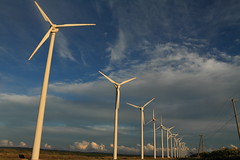 In the wake of the Japanese earthquake and tsunami, Japan's food supply is being poisoned by nuclear radiation. That's after oil refineries and natural gas storage tanks exploded and burned. But wind power - whose reliability is constantly questioned by advocates of our energy status quo - survived the disaster without a scratch:
In the wake of the Japanese earthquake and tsunami, Japan's food supply is being poisoned by nuclear radiation. That's after oil refineries and natural gas storage tanks exploded and burned. But wind power - whose reliability is constantly questioned by advocates of our energy status quo - survived the disaster without a scratch:While Japan's water-dependent nuclear power plants suck and wheeze and spew radioactive steam, "there has been no wind facility damage reported by any [Japan Wind Energy Association] members, from either the earthquake or the tsunami," says association head Yoshinori Ueda.Wind's clutch performance is especially notable in light of how much Japanese power companies have resisted it.
Even the country's totally badass Kamisu offshore wind farm, with its giant 2 MW turbines with blades big as the wings on a jumbo jet, and only 186 miles from the epicenter of the largest quake ever recorded in Japan, survived without a hiccup thanks to its "battle proof design." As a result, the nation's electric companies have asked all of its wind farms to increase power production to maximum, in order to make up for the shortfalls brought about by the failure of certain other aging, non-resilient 20th-century technologies.
Here in the United States, when we're making our energy choices we ignore things like how well they'll survive a disaster, or how vulnerable they'll leave us to global price shocks, or how many cases of asthma they'll cause. Instead, we pick our energy sources almost solely on how cheaply they can produce a unit of electricity. We get low prices in the short term, but like Japan's shaky nuclear construction, what long-term bills may come due?

No comments:
Post a Comment